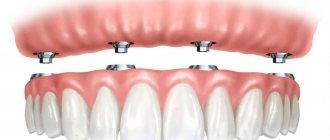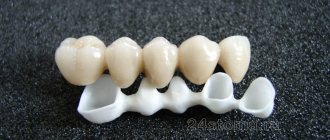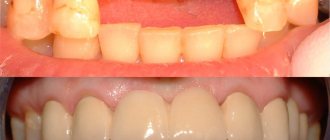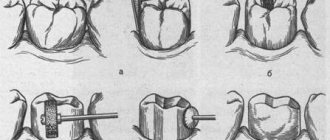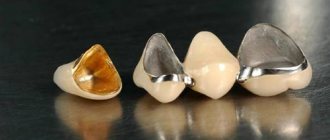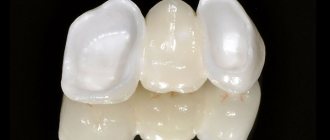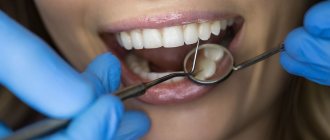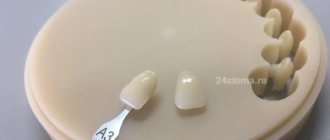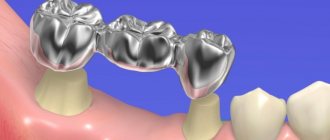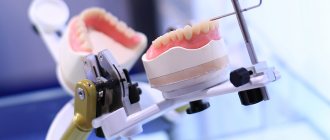Like any dental structure, crowns have their own service life. When the crown no longer serves its functional purpose, it will need to be removed and removed. There are also unforeseen situations that require immediate crown removal. So, in what cases is crown extraction necessary?
- The tooth was not properly prepared for a crown. If the filling quality is poor, there is a high chance of inflammatory processes occurring. When a patient presents with severe pain under a crown and re-treatment is required or even at risk of tooth extraction, the crown will have to be removed.
- The cement on which the crown was attached was destroyed. If it is impossible to restore the cement without removing the crown, it will need to be removed.
- In the case when quite a lot of time has passed after the installation of the crown and its service life has come to an end, there is a need for re-prosthetics. Re-prosthetics are also possible if the patient wants to replace his old crown with a modern and more aesthetically acceptable one.
- If a defect in the manufacture of the crown is detected, for example, when it does not cover the neck of the tooth tightly enough or negatively affects the bite.
- If the crown becomes loose or falls out.
What are metal-ceramic dental crowns and bridges made of?
The crown consists of 2 parts – the frame and the covering.
If the crown is metal-ceramic, then the frame is made of metal . In the Health Clinic Istok is a special alloy made in Germany - GIALLOY . The frame is covered with ceramic mass , which is baked in an oven at 400C. The color of the ceramic mass is selected by the doctor in accordance with the color of your teeth or at the request of the patient. The Istok Health Clinic uses ceramics from well-known manufacturers Noritake, Ivoclar, Duceram Plus, e-max Ceram
Indications for removal
Crowns are removed when necessary. The prosthesis can last about 10 years if the rules of care and oral hygiene are observed. After the expiration of the intended service life, it is advisable to replace the structure. Indications for replacing a dental product:
- Mechanical damage, cracks, chips.
- The occurrence of an inflammatory process under the prosthetic structure.
- Incorrect installation. Gaps between the device and the gum. Inconsistency of the design with the anatomical features of the patient’s jaws.
- Loosening and loss of the product due to destruction of the cement base.
- The patient’s desire to replace the prosthesis with a modern design.
If you experience discomfort, pain under the crown, bad breath, swelling and redness of the gums adjacent to the denture, you should immediately contact your dentist. This will prevent the development of complications.
Stages of manufacturing and installation of a metal-ceramic crown and bridge.
So, what stages do you need to go through in order to have a crown or bridge made of metal ceramics in your mouth?
Preparing teeth for prosthetics
Before installing a crown, the tooth must be cleaned, treated, and old restorations removed.
Installation of the stump tab
If the tooth decay is very extensive and there is not enough tissue, then it may be necessary to install a stump inlay - a base for installing a crown.
Tooth turning
To obtain an ideal surface for the future crown to fit, the doctor gives the tooth a certain shape. To prevent food from getting in and causing caries to develop under the crown, in our Clinic we grind the tooth using the “ledge” method.
Taking impressions
To create the exact shape of the future crown, the doctor takes impressions of the teeth using a special impression mass, which subsequently hardens (model)
Making a crown
Using the resulting model of the equipment, a metal frame is cast in our laboratory, covered with ceramics and baked at high temperature. To give the crown strength and more reliable fixation, in our Clinic we use shoulder masses.
Fixation of the crown
The doctor fixes the resulting crown on a metal-ceramic frame using special cement.
How to remove crowns
The procedure for removing dental appliances is the responsibility of orthopedists and endodontists. Doctors have various techniques for removing dental structures at their disposal.
- Cutting the prosthesis using a bur
Traditional method of removing a single prosthesis. The artificial material is sawn and removed from the oral cavity. The procedure must be performed by a qualified and experienced physician. The method is suitable for dismantling budget or damaged models.
- Dismantling using ultrasound
Fast and safe removal method. Under the direct influence of ultrasonic waves on the composition, the binder material is destroyed. The product is removed undamaged. The method is suitable for models made of low-density materials.
- Manual crown remover
The work is performed using a special tool with metal hooks attached to the end. The dentist carefully hooks the edges of the dental device and removes it.
- Application of the Koch apparatus
Externally, the device looks like a crown remover. The product is equipped with a hook at the end and an activation button that provides mechanical action to destroy the cement. After the prosthesis becomes mobile, the doctor removes it with forceps.
- Coronaflex
The appearance of the device resembles a pistol. The device contains compressed air, which, after activation, flows out under high pressure. Under the influence of an air jet, the cement base of the crown is destroyed. The prosthesis and mucous membrane are not damaged.
This method applies to modern and expensive dental procedures. The method is suitable for removing expensive prosthetic models.
How long does it take to place a metal-ceramic crown on a tooth?
The duration of treatment depends on the condition of the teeth that we are going to replace. If the tooth is not bothering you and it’s just time to change the metal-ceramic crown, then you will need 2 visits within 5-7 days. If the tooth has not yet been treated, then two visits within 5-7 days are usually sufficient. If the tooth was previously healed, replaced with prosthetics and began to bother you, then you will first have to re-treat it, and only then make and install a new crown. During treatment, the doctor may suggest that you install a temporary crown.
Algorithm of the doctor’s actions after the procedure
After removing the product, the dentist performs a clinical examination of the tooth. X-ray diagnostics are performed. The dentist’s actions depend on the clinical situation:
- Treatment of the inflammatory process. If there are signs of pulpitis, periodontitis or other pathologies, the doctor removes the pulp and cleans the canals, applies medicine and installs a temporary filling. After the inflammation is eliminated, a filling is performed.
- Restoration. Helps prevent destruction of dental tissues due to cracks in the crown.
- Replacement of dental cement.
- Complete replacement of an artificial crown.
Self-removal of the crown
Self-removal of a dental prosthesis is strictly prohibited. Only a qualified doctor can perform the procedure correctly. When removed at home, there is a risk of damage to the crown, injury or infection of the mucous membranes.
Is it painful to install a metal-ceramic crown?
Installing a metal-ceramic crown is a completely painless process.
The only unpleasant moment may be taking impressions with impression material, especially if you have an increased gag reflex. In this case, it is better to resort to 3D prosthetics CEREC.
Preparing to install dental crowns
Traditionally, crowns are placed on dead (pulpless) teeth, but sometimes there is a need to install a structure on living teeth. This has a positive effect on the final result of prosthetics, since living dental units are stronger and less susceptible to destruction processes, which ensures a long useful life of the crown. Usually, chewing teeth are not depulped during prosthetics. They have a significant area of the natural crown and the distance from the enamel layer to the pulp is greater, which eliminates burns to the natural tissues of the oral cavity during prosthetics.
Which dentistry in Zvenigorod is best to choose for prosthetic crowns?
There are many dental clinics in Zvenigorod.
One of them is the dental department of the Istok Health Clinic. The dental clinic has been operating in Zvenigorod since 1992. There are 7 dental offices equipped with the most modern equipment, its own dental laboratory, X-ray room, and sterilization department. Here you can receive a full range of dental services, and you can get an appointment at virtually any convenient time. The Clinic's management closely monitors the quality of services provided and materials used.
Indications for prosthetics by installing dental crowns
There are certain indications for installing a crown on a tooth, as for any other dental procedure. In what cases is prosthetics with dental crowns performed? It would be advisable to carry out the procedure in the following circumstances:
- Significant destruction of dental units by deep caries.
- Traumatic tooth destruction, in which the unit still has healthy roots.
- Aesthetic defects: noticeable discoloration of the enamel coating, chips.
Also, the installation of temporary crowns will be justified in case of periodontitis: the design will prevent further loosening of the teeth and, accordingly, will protect them from falling out. Indications for crown installation are determined during a diagnostic examination. Do you need to get a crown on your tooth? The orthopedists of our dentistry in Moscow - VENSTOM - will help you find the answer to this question! Come see a specialist at any time convenient for you. We are located next to the Baumanskaya metro station, you can walk to the clinic from the metro in just five minutes!
Materials
The choice of the type of denture and bridge (photo below) depends on the clinical picture and the wishes of the patient. Before installation, criteria such as wearing comfort, visual appeal, and service life are taken into account. All these parameters primarily depend on what base the device is made of. Most often, clinics offer metal-ceramic and ceramic products, as they have many advantages.
Plastic is also used to make microprostheses. They are suitable only for temporary wear, since they are short-lived, inconvenient, and quickly become unusable. During this time, the appearance also changes, the plastic base turns yellow, becomes dark or completely collapses. Such unreliable elements must be installed during the production of permanent bridges.
Metal ceramics
Metal-ceramic dental bridge - what is it in dentistry (photo below), what are its advantages? The product is based on a metal frame, which is covered with ceramics on top. The service life is more than 7-8 years, all this time the external attractiveness is maintained.
Other benefits:
- wear resistance, strength, durability, resistance to mechanical stress;
- aesthetics;
- complete restoration of the patient’s chewing function;
- low cost;
- minimal risk of developing allergies.
This is the most popular type of bridge structure. When choosing a material, it is important to pay attention to existing limitations.
When should you not insert a metal-ceramic prosthesis?
Contraindications:
- absence of four or more units;
- pathological changes in bite;
- bruxism (grinding mainly during sleep);
- gum disease;
- abrasion of incisors;
- inflammation in the oral cavity;
- parafunctions of the masticatory muscles;
- insufficient height of supporting elements;
- poor hygiene and subsequent infection;
- problems with blood clotting;
- allergic reactions to components;
- mental disorders.
Dental bridges that exist today are different from those that existed previously. Just a couple of decades ago, installation of the product was unacceptable for many diseases. Now this list is not so extensive. Materials are becoming more advanced, modern technologies make the procedure accessible to everyone.
Metal
Such models are cast and stamped. Attribution to one type or another depends on the method of connection. The elements are made of gold, as well as alloys of chromium with cobalt or nickel.
With one-piece casting, the dentition may experience significant stress. The shape of the crowns is reproduced with amazing accuracy.
Stamping means that the parts are soldered to each other. They are unreliable and cause galvanic syndrome. At the moment, they are practically not produced, since the products are not aesthetically pleasing enough, and the price of the precious metals used can be high.
Disadvantages of using metal alloys
Negative sides:
- a iron taste appears in the mouth;
- unattractive compared to metal ceramics;
- the likelihood of oxidative processes that affect the state of the gastrointestinal tract (typical for old-style models).
Plastic
Doctors note that a dental bridge is a product that can be worn for years and does not lose its attractiveness and functionality. Plastic elements are created from a special polymer containing acrylic. The results are aesthetically attractive prostheses that are hypoallergenic and free of discomfort for the wearer.
However, such microprostheses have significant disadvantages. They are fragile and wear out quickly. It is for this reason that their scope of application is quite narrow; they are suitable only for temporary use while a model is being made from metal-ceramics or a metal alloy. In addition, plastic surgery is indicated in cases where it is necessary to eliminate aesthetic defects of the anterior incisors that do not experience constant stress, and the patient is limited in finances, but wants to look presentable.
When is a prosthesis needed?
Loss of teeth is not only an aesthetic problem. The absence of one or more elements in a row leads to negative consequences:
- The functioning of the digestive system is disrupted. This is due to the fact that products that are not crushed enough when chewed enter the gastrointestinal tract.
- Atrophic processes in bone tissue, external deformation of the maxillofacial apparatus. Due to the lack of incisors, canines or molars over a long period of time, the jaws do not receive sufficient load, and their functions are gradually lost.
- Change in bite. Healthy units fill the empty space, moving to the sides. Wide interdental spaces are formed.
To prevent the complications listed above, it is recommended not to delay prosthetics and visit a doctor as soon as possible. An experienced physician is able to assess the true extent of the problem. He will select the appropriate option, which will help in a particular case.
Is it possible to treat a tooth under a crown without damaging it?
Treatment of a tooth prosthetized in this way can take place:
- without the need to remove and damage the integrity of the crown (resection through the bone tissue of the root apex, if the problem is poor-quality filling or inflammation of this particular area;
- with partial damage to the crown, but with the possibility of preserving it (the tooth is treated through a hole drilled in the prosthesis, which is then filled using the standard method);
- with crown removal and the need for re-prosthetics.
It is simply not advisable to use a prosthesis that is deformed in this case, since it loses its characteristics, and its installation will lead to even greater problems. This method is used in almost all cases when a pin is installed along with the prosthesis, the tooth is alive (installation of a crown without pulp removal), it is necessary to refill the root canals, etc.
Rules
Removing stamped crowns requires the dentist to be careful, since the procedure can easily injure the soft tissues in the neck of the tooth. There are two methods of carrying out.
- Using a scaler or crown remover. Stamped crowns have thin walls, so it is often possible to remove them entirely after first destroying the cement.
- Sawing with a dental bur. They make an incision from the edge of the microprosthesis to the chewing surface of the tooth or vertically saw through the wall.
The choice of removal method depends on the location of the crown and the condition of the fixing cement.
